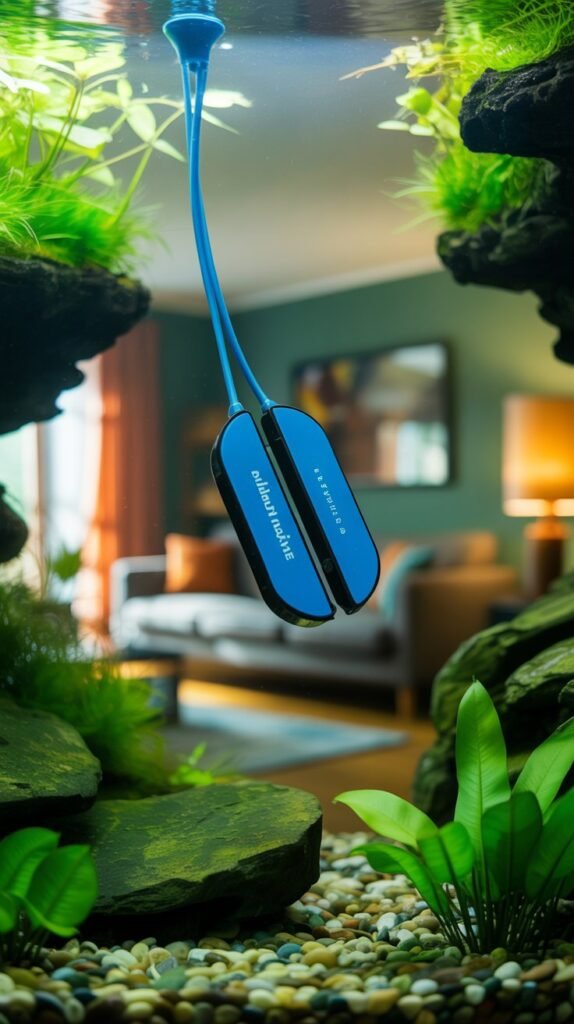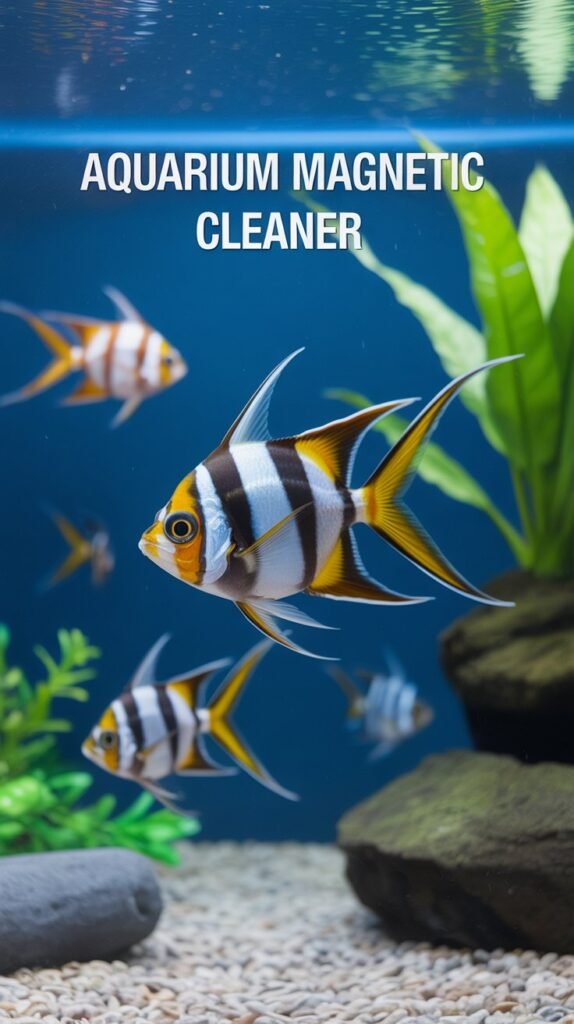Keeping an aquarium clean is not just about aesthetics—it is about maintaining a healthy environment for your fish, plants, and other aquatic life. One of the most frustrating issues aquarium hobbyists face is algae buildup on the glass. Scrubbing it manually can be tedious, time-consuming, and often results in streaks or scratches if the wrong tools are used. That’s where the aquarium magnetic cleaner comes in—a must-have tool for effortless, safe, and efficient cleaning.
In this comprehensive guide, we’ll dive deep into what aquarium magnetic cleaners are, how they work, their benefits, the best practices for using them, and how to choose the right one for your tank. Whether you are a beginner or an experienced aquarist, this article will help you understand why an aquarium magnetic cleaner should be part of your aquarium maintenance toolkit.
What is an Aquarium Magnetic Cleaner?
An aquarium magnetic cleaner is a two-part cleaning tool designed to remove algae and other debris from aquarium glass without the need to put your hands in the water. It consists of:

- An inner cleaning pad – This goes inside the aquarium and attaches to the glass. It usually has a scrubbing surface that removes algae effectively.
- An outer handle magnet – This stays outside the aquarium. When moved, it pulls the inner cleaning pad along the glass.
The magnets inside both parts keep them tightly connected through the glass. By moving the external handle, the inner pad moves along with it, cleaning the aquarium glass effortlessly.
Why Do You Need an Aquarium Magnetic Cleaner?
Aquarium glass cleaning is an ongoing battle for aquarists. Here’s why an aquarium magnetic cleaner is essential:
- Convenience: No need to wet your hands or disturb fish while cleaning.
- Time-Saving: Cleans algae faster than traditional scrubbing methods.
- Less Mess: No spillage or water splashes compared to manual cleaning.
- Safe for Fish: Fish remain undisturbed as you clean from the outside.
- Daily Maintenance: Encourages frequent cleaning, preventing algae overgrowth.
Types of Aquarium Magnetic Cleaners
There are different types of aquarium magnetic cleaners, and choosing the right one depends on your tank size, glass thickness, and algae problem.
1. Standard Magnetic Cleaners
- Designed for light to moderate algae.
- Ideal for small to medium aquariums.
- Lightweight and easy to use.
2. Floating Magnetic Cleaners
- Designed with buoyancy so the inner part floats if it detaches.
- Prevents the pad from sinking into the substrate.
- Perfect for beginners.
3. Heavy-Duty Magnetic Cleaners
- Built for large tanks with thick glass or acrylic.
- Strong magnets for tough algae and biofilm.
- Often include blade attachments for stubborn spots.
4. Acrylic-Safe Magnetic Cleaners
- Equipped with softer pads to avoid scratching acrylic aquariums.
- Highly recommended if you own an acrylic tank, as glass cleaners can cause damage.
Benefits of Using an Aquarium Magnetic Cleaner

1. Prevents Algae Buildup
Algae can quickly cover glass surfaces, making aquariums look dirty. A quick swipe with a magnetic cleaner a few times a week prevents buildup.
2. No Hand Contact with Water
Reduces exposure to harmful bacteria, chemicals, or irritants in the tank water.
3. Fish Safety
No risk of startling fish with large cleaning tools—fish usually adapt quickly to the gentle movement of the magnetic cleaner.
4. Reduces Tank Stress
Fish remain calm since cleaning is done externally.
5. Easy Access
Cleans hard-to-reach spots, including edges and corners, without moving rocks or decorations.
How to Use an Aquarium Magnetic Cleaner
Using an aquarium magnetic cleaner is simple, but following proper steps ensures effective cleaning and prevents scratches:
- Choose the Right Size – Match your cleaner to the glass thickness of your aquarium.
- Place the Inner Pad – Attach the scrubbing side to the inside of the aquarium glass.
- Attach the Outer Handle – Align the magnetic handle outside so both parts connect.
- Move Slowly – Guide the outer handle in straight lines across the glass.
- Cover All Areas – Clean top to bottom and side to side to prevent streaks.
- Detach Carefully – Separate magnets when done to avoid pinching fingers or cracking glass.
- Rinse After Use – Wash the inner pad with freshwater to remove algae debris.
Best Practices for Using an Aquarium Magnetic Cleaner
- Use Daily: A few quick passes every day keep algae from hardening.
- Avoid Sand Contact: Don’t let the inner pad touch the substrate—grains of sand can scratch glass.
- Check Pads Regularly: Replace worn or dirty pads to prevent scratching.
- Work Slowly: Moving too fast can cause the magnet to detach.
- Use Acrylic-Safe Pads: If you own an acrylic tank, never use regular pads.
Common Mistakes to Avoid
- Using the Wrong Size Cleaner – Weak magnets won’t work on thick glass, and strong ones may damage thin glass.
- Ignoring Sand or Gravel – Trapped grains can leave deep scratches.
- Not Cleaning Regularly – Waiting too long makes algae tougher to remove.
- Using One Pad for All Tanks – Always use separate pads for different aquariums to avoid cross-contamination.
How to Choose the Best Aquarium Magnetic Cleaner

When shopping for an aquarium magnetic cleaner, consider the following factors:
- Tank Size – Larger tanks need stronger magnets.
- Glass Thickness – Always check manufacturer recommendations.
- Material – Use acrylic-safe cleaners for acrylic tanks.
- Floating vs Non-Floating – Floating models are beginner-friendly.
- Scrubbing Surface – Look for high-quality pads or blade options.
- Brand Reliability – Trusted brands ensure durability and safety.
Popular Aquarium Magnetic Cleaner Brands
Some of the top brands aquarists trust include:
- Flipper Cleaner – Known for dual-sided design with scrubbing pad and blade.
- Mag-Float – Famous for floating cleaners that never sink.
- Aqueon – Offers budget-friendly, reliable options.
- Kedsum – Heavy-duty magnetic cleaners for thick glass.
- Tunzie Care Magnet – Compact and effective for precise cleaning.
Maintenance Tips for Aquarium Magnetic Cleaners
- Rinse pads after every use with clean water.
- Store in a dry place to prevent mold.
- Replace pads or blades when worn out.
- Avoid chemicals on the pads—stick to plain water cleaning.
Advantages Over Traditional Cleaning Tools
Compared to scrapers, sponges, or brushes, aquarium magnetic cleaners stand out because:
- They don’t require submerging hands.
- They clean more efficiently in less time.
- They minimize stress on fish.
- They reduce the risk of contamination.
- They encourage frequent maintenance due to ease of use.
Conclusion
An aquarium magnetic cleaner is one of the most practical tools every aquarist should own. It makes aquarium maintenance simple, efficient, and enjoyable while ensuring your fish live in a crystal-clear environment. Whether you have a small freshwater tank or a large saltwater setup, investing in the right aquarium magnetic cleaner will save you time, effort, and frustration.
If you are serious about keeping your aquarium beautiful and your fish healthy, this tool is worth every penny.
FAQs About Aquarium Magnetic Cleaners
1. Are aquarium magnetic cleaners safe for fish?
Yes, they are safe. The cleaning process happens outside the glass, and fish usually get used to the movement quickly.
2. Can I use a magnetic cleaner on acrylic tanks?
Yes, but only if you buy an acrylic-safe magnetic cleaner. Standard ones can scratch acrylic surfaces.
3. How often should I use an aquarium magnetic cleaner?
Using it 3–5 times a week is ideal to prevent algae buildup. For best results, daily use is recommended.
4. What if the cleaner detaches and falls in the tank?
If you have a floating model, it will rise to the surface. Non-floating ones may sink, so carefully retrieve them.
5. Can magnetic cleaners remove hard algae?
Standard models handle soft algae well, but for stubborn algae, heavy-duty cleaners with blade attachments are best.
6. Do magnetic cleaners scratch glass?
They don’t, as long as you keep sand and grit away from the scrubbing pad and replace worn pads regularly.
7. Are they worth the investment?
Absolutely. They save time, reduce stress on fish, and make regular cleaning easy, keeping aquariums spotless.

